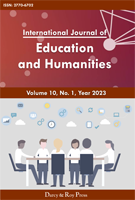On the Translation of the Chapter 31 of A Dream of Red Mansions from the Perspective of Relevance Theory
DOI:
https://doi.org/10.54097/ijeh.v8i3.8392Keywords:
A Dream of Red Mansions; Relevance Theory; Translation methods; Optimal relevance.Abstract
As one of the four famous works in China, A Dream of Red Mansions enjoys reputation of all over the word and gains numerous readers. It reflects the background and conditions of Chinese ancient feudal society. To this end, it remain a great work in Chinese literature. Moreover, its language is simple, natural, beautiful and humorous. There are many Chinese cultural words in it, which need the translator to think deeply, and then translate, figure out the tone of the article and combine the context to achieve the harmony among the author, translator and reader. This paper aims to analyze the translation of words and sentences in Chapter 31 of A Dream of Red Mansions under the guidance of the Relevance Theory. And it seeks to find the translation methods and strategies that can be adopted when using the Relevance Theory, with the aim to achieve the optimal relevance between the source text and the target text.
Downloads
References
Gutt,E.A.Translation and Relevance:Cognition and Context.Shanghai Foreign Language Education Press.2004.
Gutt, Ert -August. Translation and Relevance -Cognition and Context [M].Oxford: Basil Blackwell. 1991.
Wang Jianguo. On the Limitations of Relevance Theory in Translation Studies [J]. Language and Translation (Chinese), 2003 (1): 37-40.
Li Yin, Luo Voter. Relevance and Translation [J]. Foreign Language and Foreign Language Teaching, 2004 (1).
Zhu Yan. Relevance Theory and Stylistic Translation Research [M]. Changsha: National University of Defense Science and Technology Press, 2007.
Li Xianjin. Cultural Default and Translation Strategies from the Perspective of Relevance Theory [J1. Foreign Languages, 2013,29 (03): 112-116.
Lin Kenan. Introduction to Relevance Translation Theory [J]. Chinese Translation, 1994, (04): 8-11.
Li Zhanxi, Research on Translation for Foreign Languages in China: A Review, Commentary, and Prospects, Shanghai Translation, 2008: 20-26.
Meng Jiangang, "The Explanatory Power of Relevance Theory on Translation Standards", published in "Translation of Science and Technology in China", Vol. 14, Issue 1, 2001,9-11.
Ma Li, The Influence of Contextual Culture on the Translation of British and American Literature [J]. Journal of Heihe University, 2021,12 (3): 124-126.
Wei Taina, Context Analysis and Translation Word Selection [J]. Campus English, 2017 (7): 244.
Wang Kefei and Wang Yingchong, On the Translation of Cultural Vocabulary with Chinese Characteristics IJ1. Foreign Language and Foreign Language Teaching, 2016 (6): 87-93149-150.
Wang Jianguo. Review and Prospect of Relevance Translation Theory Research [J]. China Translation, 2005 (4): 21-26.
Meng Jiangang, The explanatory power of relevance theory on translation standards [J]. China Science and Technology Translation, 2001 (1): 9-11, 47.
Xu Xinrui. Translation of Chinese Characteristic Expressions in Press Conferences from the Perspective of Relevance Adaptation Model [D]. School of Foreign Affairs, 2020.
He Ziran, A Cognitive Study of Speech Communication [J]. Shanghai Foreign Language Education Press, 2006.
Ramos YF, A Decade of Relevance Theory. [J] Jounal of Pragmatics,1998.
Malmkjaer, Kirsten. Review: Translation and Relevance: Congnition and Context by E.A.Gutt Mind and Language, 1992(7):298-309.
Newmark Peter. Paragraphs on Translation [M] Clevedon: Multilingual Matters, 1993:105.
The explanatory power of Meng Jiangang's Relevance Theory on Translation Standards [J]. China Science and Technology Translation 2001 (01): 9-11+47.


















